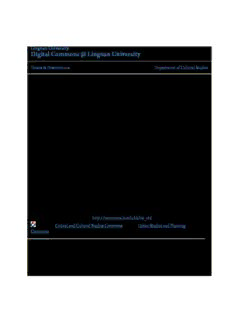
Hidden agenda? PDF
Preview Hidden agenda?
Lingnan University Digital Commons @ Lingnan University Theses & Dissertations Department of Cultural Studies 9-1-2014 Hidden agenda? Cultural policy in Hong Kong’s urban redevelopment Tobias ZUSER Follow this and additional works at:http://commons.ln.edu.hk/cs_etd Part of theCritical and Cultural Studies Commons, and theUrban Studies and Planning Commons Recommended Citation Zuser, T. (2014).Hidden agenda? Cultural policy in Hong Kong’s urban redevelopment (Master's thesis, Lingnan University, Hong Kong). Retrieved from http://commons.ln.edu.hk/cs_etd/21 This Thesis is brought to you for free and open access by the Department of Cultural Studies at Digital Commons @ Lingnan University. It has been accepted for inclusion in Theses & Dissertations by an authorized administrator of Digital Commons @ Lingnan University. Terms of Use The copyright of this thesis is owned by its author. Any reproduction, adaptation, distribution or dissemination of this thesis without express authorization is strictly prohibited. All rights reserved. HIDDEN AGENDA? CULTURAL POLICY IN HONG KONG’S URBAN REDEVELOPMENT by ZUSER Tobias A thesis submitted in partial fulfillment of the requirements for the Degree of Master of Philosophy in Cultural Studies LINGNAN UNIVERSITY 2014 ABSTRACT Hidden Agenda? Cultural Policy in Hong Kong’s Urban Redevelopment by ZUSER Tobias Master of Philosophy For many years industrial buildings in Hong Kong have formed some of the city’s most vibrant cultural clusters by providing local artists with low-cost space to pursue their creative work. However, recent efforts by the government also targeted these areas for commercial revitalization. By 2020 the industrial part of Kwun Tong, a densely populated district in Kowloon East, will not only have been transformed into the city’s second Central Business District, but also seen the majority of the current cultural workers leaving due to the rapid valorisation of land. Nevertheless, these on- going struggles over spatial power have also opened up a new space for a critical debate on Hong Kong’s urban planning and cultural policy strategies. This research uses the non-compliant Kwun Tong livehouse Hidden Agenda as a case study to shed light on the prospects for Hong Kong’s cultural diversity in its material, social and symbolic form of cultural clusters. By critically investigating research across different disciplines, I argue that—although the mere exposure of the contradictions between cultural planning and urban creativity discourses is significant—the governmental conditions that have been enabling the emergence of such spaces in the first place are often neglected by scholars and planners alike. Therefore, in order to understand both the destructive and productive impact of spatial power on Hong Kong’s cultural production, this thesis aims to examine the room for maneuvers within planning and policy discourses by expanding the Foucauldian approach of cultural policy studies to the domain of space. CONTENTS LIST OF TABLES .................................................................................. iv LIST OF IMAGES .................................................................................. v LIST OF ABBREVIATIONS ................................................................ vi ACKNOWLEDGEMENTS ................................................................. viii 1 INTRODUCTION .................................................................................. 1 1.1 Background .................................................................................................. 2 1.2 Research Questions ...................................................................................... 9 1.3 Methodology .............................................................................................. 13 1.4 Objectives and scope .................................................................................. 14 1.5 Structure ..................................................................................................... 16 2 CONCEPTUAL FRAMEWORK ............................................................ 18 2.1 Space and the City ...................................................................................... 19 2.1.1 The Production of Other Space ........................................................................ 20 2.1.2 The Gentrification Trap .................................................................................... 24 2.1.3 Hong Kong: “The Paradigm City” .................................................................. 28 2.2 Culture and Space ...................................................................................... 32 2.2.1 Cultural Cluster Confusion .............................................................................. 32 2.2.2 The Creative Turn ............................................................................................. 34 2.2.3 Hong Kong: “Asia’s World City” ..................................................................... 38 2.3 Policy and Culture ...................................................................................... 39 2.3.1 Resistance and Governmentality ...................................................................... 41 2.3.2 (Sub)Cultural Citizenship ................................................................................. 44 i 2.3.3 Hong Kong: “The best cultural policy is no cultural policy” .......................... 46 2.4 Relevance of Concepts ............................................................................... 48 3 CASE STUDY: HIDDEN AGENDA ....................................................... 50 3.1 Production of a “Kwun Tong livehouse” ................................................... 51 3.1.1 Perceiving Kwun Tong ..................................................................................... 52 3.1.2 Conceiving Kwun Tong .................................................................................... 55 3.1.3 Living Kwun Tong ............................................................................................ 57 3.2 Hidden Agenda: Space, Policies, Discourses ............................................. 59 3.2.1 Generation Gap ................................................................................................ 60 3.2.2 Hybrid Space: illegal, sub-cultural, commercial? ........................................... 67 3.2.3 “Room for Maneuvers” within Non-Cultural Policies .................................... 72 3.2.4 Friend or Foe: Energizing Kowloon East Office ............................................. 78 3.3 Just another Fo Tan? ................................................................................... 87 3.3.1 Cultural Sustainability ..................................................................................... 88 3.3.2 Social Sustainability ......................................................................................... 89 3.3.3 Economic Sustainability ................................................................................... 91 3.3.4 Governmental Sustainability ............................................................................ 92 4 CULTURAL POLICY AND URBAN PLANNING .................................... 95 4.1 Cultural Clusters: Strategies, Planning, Policies ........................................ 96 4.1.1 Urban Planning in Hong Kong ........................................................................ 96 4.1.2 Cultural Clusters .............................................................................................. 99 4.2 Cultural Policy in Hong Kong’s Urban Redevelopment? ........................ 107 4.2.1 Establishing Spatial Power ............................................................................ 108 4.2.2 Struggle over Spatial Power ........................................................................... 110 4.2.3 Creative Industries and Cultural Citizenship .................................................. 113 ii 4.3 Culture Portfolio ...................................................................................... 115 5 CONCLUSION AND PERSPECTIVES ................................................. 119 EPILOGUE .............................................................................................. 127 APPENDIX .............................................................................................. 128 List of Interviewees .............................................................................................. 128 BIBLIOGRAPHY ..................................................................................... 129 iii LIST OF TABLES Table 1: Overview of Hidden Agenda's "three generations" (own table) .................. 62 Table 2: Overview of landmark events in relation to Hidden Agenda (own table) .... 67 Table 3: Selective overview of most significant past and current livehouse venues in Kowloon, Hong Kong Island and New Territories (own table) ................................. 71 Table 4: Comparison of discourses between cultural users and EKEO in relation to Kwun Tong’s redevelopment (own table) .................................................................. 87 Table 5: Overview of planned cultural clusters in Hong Kong (own table) ............ 101 Table 6: Statutory Outline Zoning Plan of current cultural clusters (own table) ..... 104 Table 7: Organization chart of departments and authorities in the HKSAR that are practically engaged with issues of urban and cultural planning (own table) ........... 117 iv
Description: